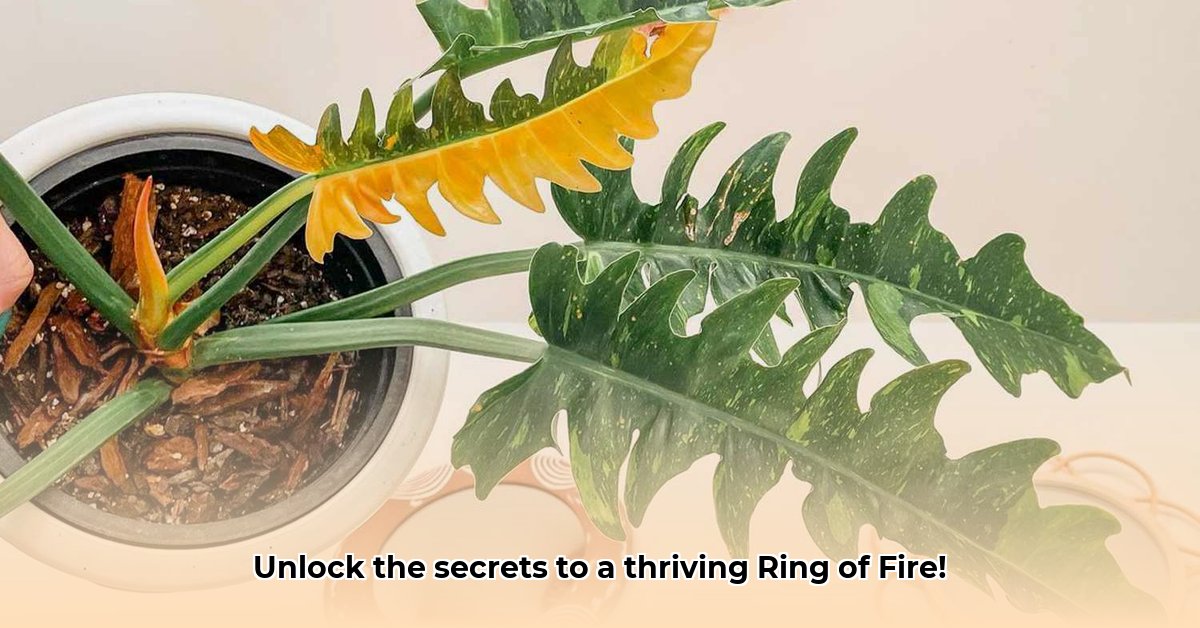Want a stunning Philodendron ring of fire but also want to be eco-friendly? You’re in the right place! This guide will show you exactly how to grow this beautiful plant without harming the planet. We’ll cover everything from the best way to propagate it (water or soil – we’ll help you decide!) to simple tips for keeping it happy and healthy for years. We’ll even look at the good and bad sides of owning one, so you can make sure it’s the right plant for you. For more plant care tips, check out this helpful resource on ribbon plants. Get ready to learn how to grow your ring of fire responsibly and enjoy its vibrant colors guilt-free!
Ring of Fire Plant: A Sustainable Growing Guide
The “Ring of Fire” plant, a Philodendron with strikingly variegated leaves, is a popular houseplant. Its vibrant blend of green, red, orange, and yellow hues makes it a showstopper in any indoor garden. But is it truly an eco-friendly choice? Let’s dive in and explore how to grow this beauty in a way that’s kinder to the planet.
Exploring Sustainable Horticulture with Ring of Fire Plant
This captivating plant, with its fiery foliage, makes a stunning addition to any home. Its popularity, however, raises important questions about its environmental impact. We’ll explore the pros and cons, and offer tips to make your growing practices more sustainable. Remember, even small changes can make a big difference!
Propagation: Growing Responsibly for a Sustainable Future
One key to sustainable plant ownership lies in propagation – creating new plants from existing ones. The Ring of Fire plant is relatively easy to propagate from stem cuttings. However, traditional methods often rely on peat-based potting mixes, which aren’t the most environmentally friendly option.
- Water Propagation: A Water-Wise Approach: This simple technique involves rooting cuttings in water. While it minimizes soil use, keep an eye on water consumption. Consider collecting rainwater or reusing water from your aquarium – after all, every drop counts!
- Soil Propagation: Going Green with Your Growing Medium: To avoid peat-based mixes, explore eco-friendly alternatives like coconut coir or a blend of perlite and vermiculite. These options offer excellent drainage and aeration without harming precious peat bogs. You can also create your own mix using compost from your household waste, further reducing your environmental impact.
The Two Sides of the Coin: Environmental Impact and Plant Choices
Like most things, the Ring of Fire plant’s environmental footprint has both positive and negative sides. Let’s weigh them carefully.
Advantages of Ring of Fire Plants:
- Air Quality Improvement: These plants can improve indoor air quality by absorbing certain pollutants like formaldehyde and xylene. While not a complete solution to air purification, they contribute to a healthier indoor environment. NASA’s Clean Air Study suggests houseplants can play a role in filtering common household toxins.
- Reduced Pesticide Use: Compared to outdoor plants, houseplants typically need fewer pesticides. Growing your Ring of Fire indoors means you are likely to use less, if any, pesticides. This reduces the risk of harmful chemicals entering the environment.
- Slow and Steady Growth: The relatively slow growth rate of this plant means fewer repotting cycles, which saves resources like water and soil. You won’t need to constantly upgrade its pot or replenish its soil.
Disadvantages of Ring of Fire Plants:
- Toxicity to Pets and Children: It’s crucial to remember that the Ring of Fire plant is toxic if ingested by pets or children. Careful placement out of reach is absolutely essential for responsible plant ownership. Consider hanging it in a macrame planter or placing it on a high shelf.
- Unknown Long-Term Ecological Impact: The overall environmental impact of mass-producing this plant is still something we need to learn more about. Commercial cultivation could potentially impact its natural habitats if not managed sustainably. Support nurseries that prioritize sustainable growing practices.
- Limited Genetic Diversity: Being a hybrid plant means it has limited genetic diversity, making it potentially more susceptible to diseases. This could lead to a greater need for the use of pesticides in the future. Propagating from cuttings further reduces genetic diversity.
Sustainable Growing: Tips for Success and Environmental Responsibility
Here’s how you can nurture your Ring of Fire plant while minimizing its environmental impact:
- Watering Wisely: The Goldilocks Approach: Water thoroughly, but only when the top inch of soil feels dry to the touch. Use a moisture meter to ensure accuracy. Overwatering is a common problem, often leading to root rot.
- Light Conditions: Bright but Indirect: Bright, indirect sunlight is ideal. Place it near an east-facing window or use sheer curtains to filter the light. Avoid direct sun, which can scorch the leaves.
- Potting Mix: Choose Eco-Friendly Options: Select a well-draining, peat-free potting mix. Coconut coir, perlite, and vermiculite are excellent alternatives. You can also amend your own soil mix with compost.
- Repotting: Only When Necessary: Repot only when the plant becomes root-bound, typically every 12-18 months. Use recycled or biodegradable pots whenever possible. Terracotta pots are a sustainable option that also allows for good airflow.
- Pest Management: Natural Solutions: Regularly inspect your plant for pests. If you find any, opt for organic pest control methods before resorting to chemical treatments. Neem oil, insecticidal soap, and diatomaceous earth are effective natural options.
- Propagation: Mindful Multiplication: Choose a sustainable propagation method that aligns with your environmental values. Share cuttings with friends and neighbors to reduce the demand for commercially grown plants.
- Responsible Disposal: End-of-Life Care: When the time comes to discard your plant, do it responsibly. Compost it or donate it to a local gardening group or school.
Looking Ahead: The Future of Sustainable Plant Ownership and Conservation
The long-term sustainability of the Ring of Fire plant, and many other popular houseplants, depends on the combined efforts of consumers, growers, and researchers. We still need to learn more about its impact on the environment over the long term. More research into developing truly sustainable propagation methods is crucial. Let’s all do our part to promote responsible plant ownership!
A Collaborative Effort: Everyone Plays a Part in Sustainable Plant Care
| Stakeholder | Short-Term Actions | Long-Term Goals |
|---|---|---|
| Home Growers | Efficient watering, use eco-friendly pots, learn sustainable propagation, choose organic fertilizers | Reduce overall environmental impact of plant ownership, share plants with others, advocate for sustainable practices |
| Commercial Growers | Optimize water and energy use; switch to sustainable soil mixes, reduce packaging waste, use renewable energy | Minimize environmental footprint; explore native alternatives, implement closed-loop systems, obtain certifications |
| Researchers | Study air purification effects; analyze long-term environmental effects, develop disease-resistant varieties | Investigate genetic diversity; develop sustainable pest control solutions, promote conservation of native species |
| Consumers | Choose responsible sellers; prioritize safe plant placement, support businesses with eco-friendly practices | Advocate for sustainable plant production and ethical sourcing, demand transparency from growers and retailers |
By making conscious choices and supporting sustainable practices, we can help ensure a more eco-friendly future for houseplants. Remember, your actions, no matter how small, contribute to a larger movement towards a healthier planet.
How to Propagate Philodendron Ring of Fire Sustainably
Key Takeaways:
- Successful propagation relies on healthy cuttings and proper techniques.
- Air layering and water propagation are viable options, each with advantages and disadvantages.
- Maintaining optimal environmental conditions—light, humidity, temperature—is crucial.
- Preventing rot and pest infestations is essential for success.
- The slow growth rate of Philodendron ring of fire requires patience and consistent care.
Choosing Your Cutting: The Foundation of Success in Sustainable Propagation
Before you even think about how to propagate philodendron ring of fire sustainably, you need a healthy start. Select a stem cutting from a thriving parent plant. Look for a section with several nodes (the points where leaves sprout) and at least one leaf. A longer cutting generally gives you a better chance of success. Avoid cuttings with any signs of disease or damage. Use sterilized pruning shears to prevent the spread of disease. Remember, a healthy parent plant is key to a healthy offspring!
Two Paths to Propagation: Air Layering vs. Water Propagation Techniques
There are two primary methods for propagating your Philodendron ring of fire: air layering and water propagation. Let’s weigh the pros and cons:
| Method | Pros | Cons |
|---|---|---|
| Water Propagation | Simple, requires less specialized equipment, easy to monitor root growth, higher success rate for beginners | Higher risk of rot, slower root development, requires more frequent water changes, can be less sustainable |
| Air Layering | Lower risk of rot, potentially faster root development, less messy, can be more sustainable by reducing water waste | More technically demanding, requires more time and attention to detail, requires more specialized equipment |
Step-by-Step: Water Propagation for Philodendron Ring of Fire
- Prepare the cutting: Cut a stem below a node
- Gray Kitchen Backsplash Tile: Ideas for a Stylish Upgrade - December 14, 2025
- Backsplash For Gray Cabinets: Choosing the Right Backsplash Style - December 13, 2025
- Gray And White Backsplash: Ideas For Timeless Style - December 12, 2025









